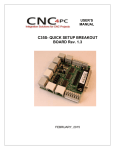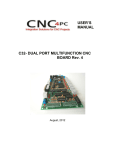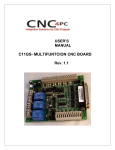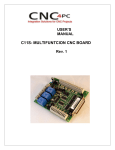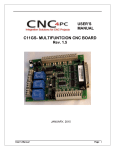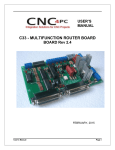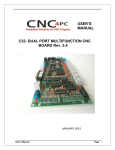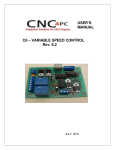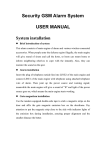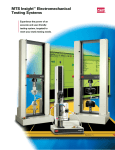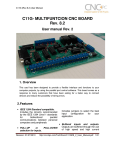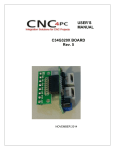Download User`s Manual Template
Transcript
USER’S MANUAL C17- MASTER CONTROL BOARD Rev. 4 SEPTEMBER, 2014 USER'S MANUAL TABLE OF CONTENTS Page # Contents 1.0 FEATURES ..................................................................................................................... 1 2.0 SPECIFICATIONS .......................................................................................................... 2 3.0 BOARD DESCRIPTION .................................................................................................. 3 4.0 WIRING ........................................................................................................................... 8 5.0 OPERATION MODES AND PROGRAM SEQUENCE: ................................................... 9 5.1 STAND-BY MODE. ........................................................................................................ 9 5.2 START-UP MODE. ........................................................................................................ 9 5.3 ACTIVE MODE. ........................................................................................................... 10 6.0 6.1 CONFIGURING THE CONTROL SOFTWARE ............................................................. 11 APPLICATION CONSIDERATIONS: ........................................................................... 11 7.0 CONNECTING EXTERNAL FAULT INDICATOR LEDS ............................................... 12 8.0 DIMENSIONS................................................................................................................ 13 User’s Manual Page i 1.0 FEATURES Monitors E-Stop, Safety Charge Pump, and Drivers (it only monitors (G320/340 drives at this time) Microcontroller Based System. The microcontroller based system allows the implementation of complex algorithms for monitoring the system. It also allows the possibility of having firmware upgrades without having to change the board and rewire your system. On-Board Relay for controlling external devices. The board comes with an on-board relay that allows you to enable a breakout board, a contactor, a motor, or any other device. Multiple relays could be connected externally in parallel if you need to control different signals and currents. For example, you might need to use the external signal to enable a breakout board, then you need another signal to enable a contactor, and then another relay to interrupt the line that powers a motor. Status LEDs on all inputs and output connections. No more guessing. You can SEE all your signals. Save valuable time and brainpower for CNCing. All TTL +5vdc or .3vdc Signals. Interface directly with parallel port interface products and other cnc4pc.com cards. 5VDC (TTL) signals are very common among automation devices. Screw-On connections for all terminals. You only have to screw-on the wires to make all your connections. Flexible design. It works with cnc4pc’s products, directly through your parallel port, or through many other parallel port control products. User’s Manual Page 1 2.0 SPECIFICATIONS DIGITAL INPUT SPECIFICATIONS On-state voltage range 2 to 5V DC Maximum off-state voltaje 0.8V DIGITAL OUTPUT SPECIFICATIONS (5V power supply voltage) + Maximum output voltage 0.5V Typical output current 24mA Maximum off-state voltaje 0.44 V Requirements: It requires a 5VDC @ 400 milliamps power supply to operate. WARNING Check the polarity and voltage of the external power source and connect the 5V and GND. Overvoltage or reverse-polarity power applied to these terminals can cause damage to the board, and/or the power source. User’s Manual Page 2 3.0 BOARD DESCRIPTION Connect power supply: Provide a 5V@400mA power supply to power the board. Terminal Input signals: In order to take the board to activate mode, the following conditions must be met: User’s Manual Page 3 1. THE TERMINALS MUST BE ACTIVATED WITH A HI OR +5VDC. The pin to the right has +5vdc and the input pin is to the left. A NC (Normally Closed) switch should be used. 2. THE SAFETY CHARGE PUMP SIGNAL MUST BE PRESENT (If this feature is enabled with the DIP switch selector). 3. THE START SWITCH MUST BE CLOSED FOR AT LEAST 5 SECONDS TO START THE CYCLE. NOTE: NO (Normally Open) switch must be used Standby indicator LED: The standby led will light to indicate that the system is ready but disabled. If the system faults it will light again to indicate that the system is ready to enable again. Fault LEDs: When the system stops, the fault indicators will light to indicate what caused the system to stop. Status LED indicator: The status LED has three modes: 1. Off when the system is off or in standby mode. 2. Blinking, when the system is coming up. 3. On when the system is active. The external terminal is the user can install an LED in outside the control box or in the control panel. Terminal ERRS/RES Drivers: The drivers enable or err/res terminals of the driver must be connected to this terminal. The pin will behave according the driver to which it was selected to operate with. If a g320 is selected, the system will not only enable the drive, but it will monitor it to see if it faults. Terminal external Trigger: When the system faults an external activation signal is sent for 3 second. This is so you can let the controller know that the system has faulted and it is coming down. Terminal Relay contacts: The relay is so you can use it to enable and disable external devices. Such as motors, contactors, VFDs, etc... Terminal of output: In this terminal connects leds external (STANDBY, STATUS) Configuration DIP-SWITCH: DIPSWITCH allows activating or deactivating the SCHP detection function, and selecting the driver to use and delays an enable signal for external devices. User’s Manual Page 4 Position 1 The enable output (Pin 17-Port 2) will be activated when the driver enable process starts. A delay in the signal activation time could be added by selecting the OFF position in the DIPSWITCH. The table below shows the delay time for each supported driver. DRIVER G320/340 G203 G210/201/Keling Viper Servo driver DELAY (Sec.) 5 2 2 5 SWITCH 1 OFF: Delayed enable output (Pin 17-Port 2). SWITCH 1 ON: Non Delayed enable output (Pin 17-Port 2). Position 2 Safety Charge Pump “SCHP”. (Pin 17 “Port 2”) This board takes advantage of Mach ability to send a specific frequency through one of the pins of the parallel port when the program is in control of the system. Selecting the SCHP operation mode Onboard DIPSWITCH allows activating or deactivating the SCHP detection function. SWITCH 2 ON: Activate the SCHP detection function. SWITCH 2 OFF: Deactivate the SCHP detection function. Note: When the Safety Charge Pump function is activated, 5V are present in the E-Stop terminal and a valid SCHP signal is present, Port 2 Pin 17 will go high. This high signal can be used to enable other external devices, such as enabling other Breakout Boards, or relays that would enable servos, VFDs, contactors, etc….Variable Speed Control (pin 14 “Port 1” ) and VFD connection. See Configuring the Control Software User’s Manual Page 5 Position 3 and 4 Select the driver you will use according to the table below. OPERATION MODE Mode 1 COMPATIBLE DRIVER DIP 3 DIP 4 G320/DG4S 0 0 Mode 2 G203 1 0 Mode 3 G210/201/Keling 0 1 Viper 1 1 Mode 4 This board includes a Microcontroller-based driver monitoring system. It performs enabling and monitoring functions for servo Drivers, and only enabling function for stepper drivers. It is required connect the driver ERR/RES (servo drivers) or EN (stepper driver) terminal to the pin 5 of each RJ45 driver connector. Here is a brief description of how these functions are performed for each operation mode. Operation Mode 1 (G320/DG4S) When the system starts, the C62 error/reset pins go to a low state (0V), making sure the driver remains disabled. When SCHP and E-Stop function are checked and validated and there is no fault signal coming from any driver, the system sends a high (5V) to the driver’s error/reset pins for about 5 seconds to enable the drivers. After that the system monitors the driver’s err/res pins. If a fault occurs on any driver (0V in driver ERR/RES pin) or an external fault occurs (E-Stop or SCHP fault), the system stops and sends an e-stop signal (Active low) to the controller. All outputs on the board are disabled and the drivers will be disabled by sending a LOW (0V) to the drivers ERR/RES pin. The system will remain that way until the conditions to restart are present again. Operation Mode 2 (G203) When the system starts, the C62 enable pins go to a HIGH state (5V). When SCHP and E-Stop function are checked and validated, the system send a LOW (0V) to the driver’s EN pin for about 2 Sec, enabling the drivers. If an external error occurs, the system stops, resets the CNC software and sends a HIGH (5V) to the drivers EN pin. The system will remain that way until the conditions to restart are present again. Operation Mode 3 (G210/201) When the system starts, the C62 enable pins go to a LOW state (0V). When SCHP and E-Stop function are checked and validated, the system send a HIGH (5V) to the Drivers EN pin for about 2 Sec, enabling the Drivers. If an external error occurs, the system stops, resets the CNC software and sends a LOW (0V) to the drivers EN pin. The system will remain that way until the conditions to restart are present again. Operation Mode 4 (Viper, Teco and Delta) When the system starts, the C62 enable pins go to a low state (0V). When SCHP and E-Stop function are checked and validated and there is no fault signal coming from any User’s Manual Page 6 driver, the system sends a high (5V) to the driver Fault output pin, enabling the drivers. After that the system monitors the driver’s Fault Output pin. If an error is generated in any driver (0V in driver Fault Output pin) or an external error occurs, the system stops, resets the CNC software and sends a LOW (0V) to the drivers to ensure they remain disabled. User’s Manual Page 7 4.0 WIRING Make sure you send a signal to the e-stop input pin your control software, so it becomes aware of the e-stop condition. Please note the sample wiring diagram bellow. User’s Manual Page 8 Fig. 2. C4 Simplified Schematic 5.0 OPERATION MODES AND PROGRAM SEQUENCE: During operation the board goes through 3 stages or modes. These are: 5.1 STAND-BY MODE. When in stand by the board does the following: a. The driver terminals are set into output mode and the board sends a signal to the drivers in order to disable them. b. Disables the relay (this disables other external devices). c. Stand-by LED lights and the STAUS LED is off. d. The first time the board is turned on all the FAULT LEDs are off. If the board is in stand-by mode as a result of a previous fault, then a LED indicating the cause of the fault will light. The possible fault causes are: estop, SCHP (Safety Charge Pump), or driver fault. e. Sends a ground or 0 to the External Trigger terminal. f. Monitors the system to see if it is ready to go to START-UP mode. The conditions to be met for the board go to into start up mode are the following: i. The board is in Standby mode. ii. E-stop is closed. iii. The SCHP signal is present (or disabled). iv. The START signal is present. 5.2 START-UP MODE. Once the start-up conditions are met, the board goes into this mode. This mode takes 5 seconds. If during these 5 seconds any of the conditions fails, then it goes to back to stand-by mode. This time period is to allow all the systems to be ready for operation. When in startup mode the board does the following: a. Monitors that the startup conditions are met. User’s Manual Page 9 b. c. d. e. f. 5.3 Enables the drivers. Activates the relay The status LED blinks. The fault and stand by LEDs are turned off. Sends a ground or 0 to the External Trigger terminal. ACTIVE MODE. After of 5 seconds when the start up period ends and the board goes into active mode If a fault condition appears, the program goes back to stand-by mode to start the cycle again. These are the actions been performed during this mode: a. The driver terminals are switched to input mode and start monitoring the drivers. b. The system monitors all the conditions for the system to remain active. These are: v. The e-stop open. It is left in the air, or receiving a ground. vi. The SCHP signal is present. (if configured). vii. The drivers are not sending a fault signal. c. The STAUTS LED lights. d. The relay is activated. e. Sends a ground or 0 to the External Trigger terminal. But if the system faults, a hi or +5vdc signal is sent for 3 seconds. This is so you can let the controller know that the system is coming down. This signal can be connected to the controller’s e-stop or limit input. f. The system halts for 3 seconds. After these 3 seconds the system could be reactivated. User’s Manual Page 10 6.0 CONFIGURING THE CONTROL SOFTWARE Safety Charge Pump: To enable the safety charge pump, make sure you enable the feature in Config / Pins&Ports / Output Pins. Enable the safety charge pump and assign the pin you are going to connect it to, as is shown in the follow Figure. Next, press the apply button. If using the external trigger, configure e-stop or assign a limit to the input pin you are using. This way the control software will be made aware of the fault condition. 6.1 APPLICATION CONSIDERATIONS: 1. Make sure you send a signal to the e-stop pin you have configured in your control software. You could take it from the same push-button you are using for e-stop, but if you take it from the on-board relay, then if a servo motor fails, then the system will let the control software know of the fault condition. 2. If you need to implement more than one external relay, you can use the on-board relay to drive as many external relays as you need. These external relays could control the following: a. The signal that starts your contactor or motors. b. The EN (enable pin) that enabled the output of breakout boards. c. Enable or disable other external devices such as VFDs or PLCs. d. Implementing external lights or LEDs in the control box or control panel that would inform the user that the system is ENABLED. User’s Manual Page 11 e. The power line of a motor. 3. Please note that by connecting the ground of a gecko drive, you are violating optoisolation of the drive. If you still want the benefit of optoisolation, you can use an optoisolated breakout board, such as the C1 – Parallel Port Interface Card to keep your system optoisolated. 7.0 CONNECTING EXTERNAL FAULT INDICATOR LEDS External indicator LEDS can be directly connected to the board without using external resistors. Just connect them for example how is shown in the follow figure, considering that the pads marked on the board with a white point correspond to the LED’s anode. User’s Manual Page 12 8.0 DIMENSIONS All dimensions are in Millimeters. Fixing holes (3.8mm) DISCLAIMER: Use caution. CNC machines can be dangerous machines. Neither DUNCAN USA, LLC nor Arturo Duncan are liable for any accidents resulting from the improper use of these devices. This board is not a fail-safe device and it should not be used in life support systems or in other devices where its failure or possible erratic operation could cause property damage, bodily injury or loss of life. User’s Manual Page 13
















